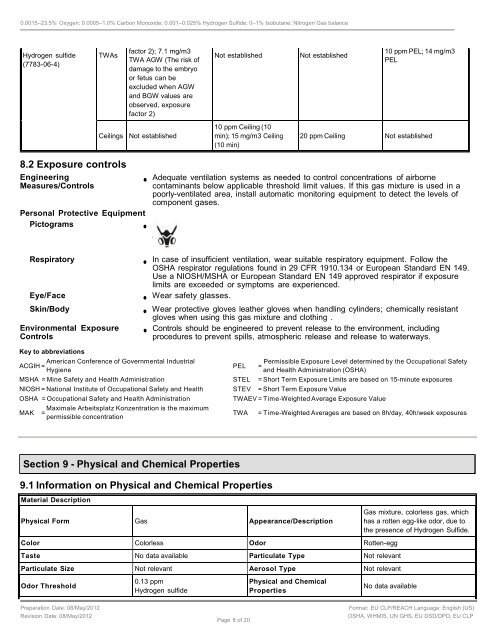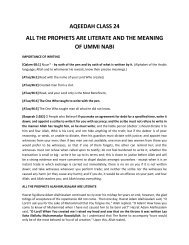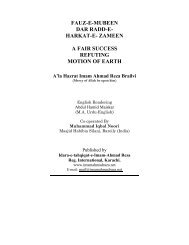81-0158RK-04
Create successful ePaper yourself
Turn your PDF publications into a flip-book with our unique Google optimized e-Paper software.
0.0015–23.5% Oxygen; 0.0005–1.0% Carbon Monoxide; 0.001–0.025% Hydrogen Sulfide; 0–1% Isobutane; Nitrogen Gas balance<br />
Hydrogen sulfide<br />
(7783064)<br />
TWAs<br />
factor 2); 7.1 mg/m3<br />
TWA AGW (The risk of<br />
damage to the embryo<br />
or fetus can be<br />
excluded when AGW<br />
and BGW values are<br />
observed, exposure<br />
factor 2)<br />
Not established<br />
Not established<br />
10 ppm PEL; 14 mg/m3<br />
PEL<br />
Ceilings Not established<br />
10 ppm Ceiling (10<br />
min); 15 mg/m3 Ceiling<br />
(10 min)<br />
20 ppm Ceiling Not established<br />
8.2 Exposure controls<br />
Engineering<br />
Measures/Controls<br />
Personal Protective Equipment<br />
Pictograms<br />
●<br />
●<br />
Adequate ventilation systems as needed to control concentrations of airborne<br />
contaminants below applicable threshold limit values. If this gas mixture is used in a<br />
poorly-ventilated area, install automatic monitoring equipment to detect the levels of<br />
component gases.<br />
Respiratory ● In case of insufficient ventilation, wear suitable respiratory equipment. Follow the<br />
OSHA respirator regulations found in 29 CFR 1910.134 or European Standard EN 149.<br />
Use a NIOSH/MSHA or European Standard EN 149 approved respirator if exposure<br />
limits are exceeded or symptoms are experienced.<br />
Eye/Face ● Wear safety glasses.<br />
Skin/Body ● Wear protective gloves leather gloves when handling cylinders; chemically resistant<br />
gloves when using this gas mixture and clothing .<br />
Environmental Exposure<br />
● Controls should be engineered to prevent release to the environment, including<br />
Controls<br />
procedures to prevent spills, atmospheric release and release to waterways.<br />
Key to abbreviations<br />
American Conference of Governmental Industrial<br />
Permissible Exposure Level determined by the Occupational Safety<br />
ACGIH = PEL = Hygiene and Health Administration (OSHA)<br />
MSHA = Mine Safety and Health Administration STEL = Short Term Exposure Limits are based on 15-minute exposures<br />
NIOSH = National Institute of Occupational Safety and Health STEV = Short Term Exposure Value<br />
OSHA = Occupational Safety and Health Administration<br />
TWAEV = Time-Weighted Average Exposure Value<br />
Maximale Arbeitsplatz Konzentration is the maximum<br />
MAK = permissible concentration<br />
TWA = Time-Weighted Averages are based on 8h/day, 40h/week exposures<br />
Section 9 - Physical and Chemical Properties<br />
9.1 Information on Physical and Chemical Properties<br />
Material Description<br />
Physical Form Gas Appearance/Description<br />
Color Colorless Odor Rottenegg<br />
Taste No data available Particulate Type Not relevant<br />
Particulate Size Not relevant Aerosol Type Not relevant<br />
Odor Threshold<br />
0.13 ppm<br />
Hydrogen sulfide<br />
Physical and Chemical<br />
Properties<br />
Gas mixture, colorless gas, which<br />
has a rotten egglike odor, due to<br />
the presence of Hydrogen Sulfide.<br />
No data available<br />
Preparation Date: 08/May/2012<br />
Revision Date: 08/May/2012<br />
Page 8 of 20<br />
Format: EU CLP/REACH Language: English (US)<br />
OSHA, WHMIS, UN GHS, EU DSD/DPD, EU CLP






